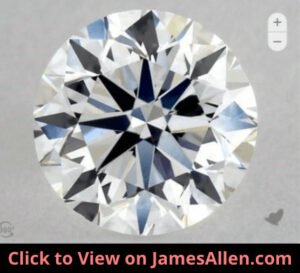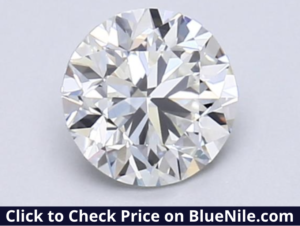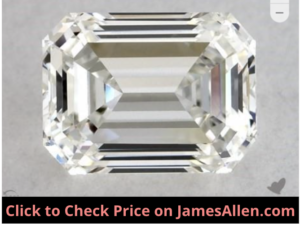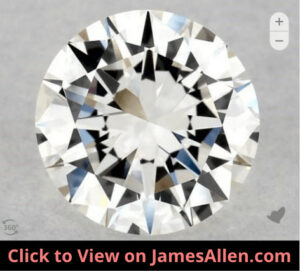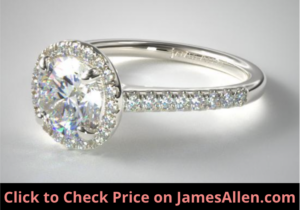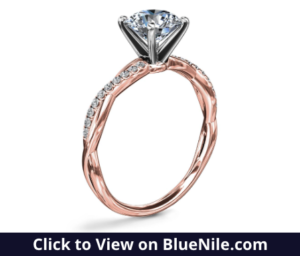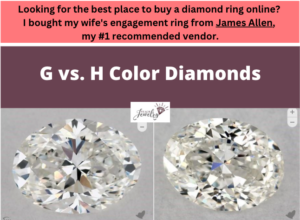
The color of a diamond is graded along a scale created by the Gemological Institute of America (GIA) that goes from D to Z.
G and H diamonds fall toward the high end of the scale in the “near colorless” category.
The main difference between G and H color diamonds is G diamonds have shades of yellow that are less visible compared to H. If you place them beside each other, they’re often indistinguishable. But you’ll pay a premium for G diamonds because of the higher color grade.
We’ll compare G and H color diamonds across the areas most important to your decision, including:
- An overview of each
- Three ways they’re different
- How to know which is right for you
What is a G Color Diamond?
A G color diamond is four positions from the top of the GIA color scale, pictured below.

There are 23 total color grades, so G exceeds the vast majority in regard to its lack of yellow tints.
It sits below three grades that make up the “colorless” category, which are D, E, and F and above the other “near colorless” grades, H, I, and J.
Although they’re designated “near colorless”, you’ll rarely notice yellow in a G diamond, even with high-resolution images.
As an example, check out this round-cut diamond from James Allen, which is the vendor where I bought my wife’s engagement ring.
It earned a G color grade. Even when you rotate the image, there’s no color to be found.
When you compare it to this D diamond, they appear identical.
But many buyers opt against a colorless diamond because of the price premium and instead choose one lower on the color scale.
What is an H Diamond?
Diamonds that earn an H color grade are still considered “near colorless” but show more yellow than ones designated G.
If you evaluate the image below, you’ll start to notice shades of color that aren’t present in higher grades.
For example, on the bottom left of that image, there’s tints of yellow, in addition to the upper right.
On the GIA color scale, H is positioned one grade below G and above I, which is fifth from the top.
Even though it doesn’t reach the status of colorless, most H diamonds appear that way to the naked eye.
For example, here’s an H diamond from James Allen.
Even in high-resolution, the color is hard to spot.
Similar to G diamonds, buyers often select H diamonds to avoid the price increase of a higher color grade.
What are Differences Between G and H Diamonds?
1. G Diamonds Show Less Color Than H
The reason a diamond receives a G versus H grade is because it shows less color.
The two grades are next to each other on the GIA scale, so the difference is slight.
Even trained jewelers don’t always agree.
It’s not always that one gemologist is grading it correctly and the other is mistaken. Instead, it underscores how it’s a subjective difference, and the distinctions are subtle.
This is a reminder of the importance of choosing a reliable certification.
Consider the following two diamonds.
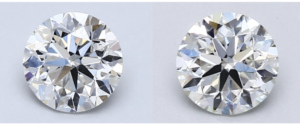
One is graded G. The other earned an H color grade. Even in high-resolution, they look identical.
Yellow tints are more pronounced in certain cuts. For example, they’re more noticeable in Asscher and emerald cuts.
Their large, step-cut facets don’t hide color as well as the smaller, brilliant-cut facets of round diamonds.
Check out this emerald cut with an H color grade.
A yellow shade is clearly visible.
Compare it to this round cut with the same grade.
It appears colorless.
I you’re considering a round cut, you can generally start your search with H color grades, but if it’s a step-cut diamond, consider G.
I always tell readers to check out the grading report for the diamond but also view a close-up image if you can’t see the diamond in-store.
2. H Diamonds Cost Less
H diamonds are less expensive than G but cost more than I or J color diamonds.
They’re more rare, so vendors can afford to charge a higher price.
The best way to demonstrate the differences in price between G and H diamonds is to compare ones that have the same grades in other areas.
I compiled prices for more than 200 round-cut diamonds from James Allen, graded by the GIA, with the following grades:
- Carat weight: 1.00
- Cut: Very good
- Clarity: VS1
Ones with G color averaged $7,622, with a range of $6,370-$8,880.
For H diamonds, the average price was $7,239. The range was $6,900-$7,860.
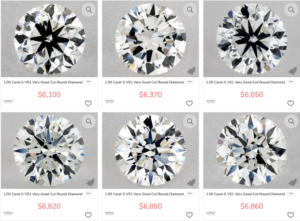
That’s a 5 percent increase in price for G versus H color diamonds.
The difference is often more significant for moving up one grade on the cut or clarity scale.
If the G and H diamonds you’re exploring appear identical to the naked eye, I recommend choosing the latter.
3. G Diamonds are More Popular for Engagement Rings
Although I often recommend H diamonds, many buyers choose G because they also offer strong value by avoiding the price jump into the colorless category.
Another reason G diamonds are more popular is because they won’t contrast with the color of pave diamonds or halos.
To illustrate, here’s an engagement ring with a halo setting that features a G diamond in the middle.
When small diamonds are placed on a setting, they typically appear colorless.
The ring would lose visual appeal if the center diamond had yellow tints, but it was surrounded by small, colorless gems.
Buyers also consider G over H diamonds for fancy cuts with large facets.
Lastly, G color diamonds pair well with rose or yellow gold settings.
For example, this engagement ring with a G color diamond is set in rose gold.
The diamond will still appear colorless even when paired with that setting.
How to Decide
G and H color diamonds are popular choices because of the value they offer compared to ones in the colorless category.
Here are some tips to help you decide which is right for you.
Consider G if:
- You’re searching for a step-cut diamond and want it to appear colorless
- You’re willing to pay a premium compared to an H diamond that may look identical
- The setting has a strong yellow or rose gold color
Opt for H if:
- You want to avoid the price increase for diamonds with higher color grades
- You’re choosing a round-cut diamond with an excellent cut
- The setting is a solitaire in white gold
By pairing G and H diamonds with different types of settings, you’ll create the right piece for you.

Jacob Clarke
Jacob Clarke is the founder of TeachJewelry.com.
He earned an Applied Jewelry Professional Diploma from the Gemological Institute of America (GIA) and now brings you essential information about diamonds, settings, and more.
Jacob has consulted with leading jewelry brands, and his work has been cited in Clean Origin, Diamond Nexus and industry publications.
He's also a member of the International Gem Society.
He enjoys discussing jewelry with readers, so contact him with any questions at jacob.clarke@teachjewelry.com.

